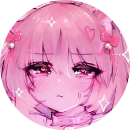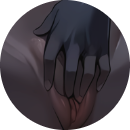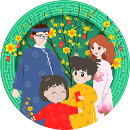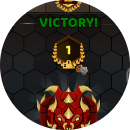hello các bạn
khách vang lãi là ai vậy trời
Cụm từ "khách vãng lai" (thường bị viết sai thành “khách vang lãi”) nghĩa là:
Người đến tạm thời, không cư trú lâu dài ở một nơi nào đó.
Đúng 0
Bình luận (0)
Cụm từ "khách vãng lai" (thường bị viết sai thành “khách vang lãi”) nghĩa là:
Người đến tạm thời, không cư trú lâu dài ở một nơi nào đó.
Đúng 0
Bình luận (1)
khách vang lãi hình như là:................. khi mô chúng ta thi đấu trường OLM là nó sẽ cộng vào ví cho mình á
Mình cũng không biết rõ lắm
Đúng 1
Bình luận (0)
Cây gì có quả màu vàng
Mang tên của một câu truyện
Ăn một quả, trả cục vàng
- Cây đó là cây gì?
- Tên câu truyện là gì?
- Cây này có mấy loại?
+Cây đó là cây thị.
+Tên câu chuyện là Sự tích cây thị.
+Cây thị có hai loại chính là thị chua và thị ngọt.
Đúng 0
Bình luận (1)
Xem thêm câu trả lời
cho mik hỏi là cách đổi mật khẩu và tên của nick học 24 và olm kiểu gì vậy ạ ?
giờ hoc24 khóa rùi nên không đổi đc tên nữa á(ykr)
Đúng 1
Bình luận (7)
Xem thêm câu trả lời
Câu: con nhà ng ta là ai? lm thế nào để k bị so vs con ng ta? bn cs phải con ng ta k
Con nhà người ta có thể là bất cứ ai VD:anh chị em nhà cô, dì, chú, bác, cậu, mợ, xa hơn là
thì mình phải giỏi hơn ,Thay đổi hướng suy nghĩ,Chứng minh rằng mình cũng có thể trở thành “con nhà người ta”
YES SIR
Đúng 3
Bình luận (1)
Kiếm GP kiểu j
Bạn cần trả lời các câu hỏi trên diễn đàn hỏi đáp OLM là được. Nhưng phải giáo viên, admin,CTV, CTVVIP thì sẽ có GP
Đúng 0
Bình luận (0)
Trl cau hoi dc CTV hoac giao vien tick thi se dc GP do bn. Con SP chac ai cx bt r ha =)))
Nen trl cau hoi nhiu v r dc tick thui :)))
Đúng 0
Bình luận (0)
Xem thêm câu trả lời
đố mn biết cơn bão mạnh nhất là cơn bão nào ?
Cơn bão mạnh nhất từng được ghi nhận là siêu bão Tip (Typhoon Tip) vào năm 1979. Đây là cơn bão có diện tích lớn nhất và sức gió mạnh nhất từng được ghi nhận trong lịch sử khí tượng.
Diện tích: Đường kính của bão Tip lên đến 2.220 km, bao phủ một vùng rộng lớn.
Tốc độ gió: Sức gió của bão Tip đạt tới 305 km/h.
Áp suất khí quyển: Áp suất thấp nhất tại tâm bão là 870 hPa, thấp nhất từng được ghi nhận.
Ngoài ra, có một số cơn bão khác cũng rất mạnh như Haiyan (2013) và Patricia (2015), cả hai đều gây ra thiệt hại lớn và có sức gió vô cùng mạnh.
Đúng 2
Bình luận (0)
Mọi người ơi, cho mik hỏi với ạ.
Tại sao mik trả lời câu hỏi xong đến lúc vào lại thì câu trả lời của mik lại ko hiện lên ạ?
Lag đấy bạn , bạn chờ một tý là được bạn ơi!
Đúng 1
Bình luận (5)
do lag đấy bn,để nó một tí là bình thường à
Đúng 2
Bình luận (0)
Xem thêm câu trả lời
Câu 1: Trái Đất có dạng hình gì?
Câu 2: Kể tên các hành tinh trong hệ Mặt Trời?
Câu 3: Việt Nam nằm ở khu vực nào trên thế giới?
1. hình cầu
2.sao Thủy, sao Kim, Trái Đất, sao Hỏa, sao Mộc, sao Thổ, sao Thiên Vương và sao Hải Vương
3.Nằm ở trung tâm khu vực Đông Nam Á
Đúng 1
Bình luận (2)
1.hình cầu, 2.Thủy Tinh, Kim Tinh, Trái Đất, Hỏa Tinh, Thổ Tinh, Mộc Tinh, Thiên Vương Tinh, Hải Vương Tinh. 3.Nằm ở trung tâm bán đảo đông dương, thuộc khu vực Đông Nam Á
Đúng 0
Bình luận (0)
1 Hình cầu
2 Mercury , Venus , Earth , Mars , Jupiter , Saturn , Uranus , Neptune
3 Nằm ở trung tâm khu vực Đông Nam Á
Đúng 2
Bình luận (1)
Xem thêm câu trả lời










































